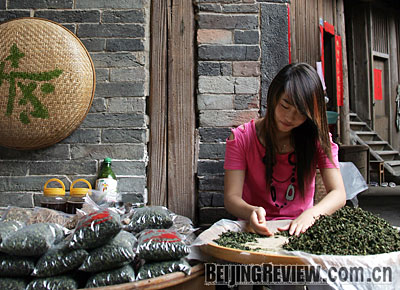|

ECONOMIC CHANGES: A local girl from Hua Yuan Tulou, in Nanjing County, Fujian Province, sorts tea leaves to sell to tourists (WANG XIANG)
"My son lives in Bu Yun, but he likes hanging around here with his best friends. We all belong to the Huang family, so there's barely a single person we don't know in the five Tulous as we are all related in some sense," said a woman in the He Chang building.
This extended family lifestyle is all about communication, according to Huang. "We communicate so frequently and so easily on all kinds of information about everything: weddings, births, internal affairs, farming and business opportunities," Huang said.
Opportunities
Every day after breakfast, people in the Tulou go about their business: children head off to school; some adults carry farm implements to work in the fields; others remain in the building to sell local products and handicrafts to tourists; and others, like Huang, drive their motorcycles to town to pick up tourists.
"Business is better than in previous years since our Tulou became a world heritage site, which made it famous across China and the world," said Huang, whose motorcycle was among dozens parked at the gate of the Tulou.
In recent years more villagers living in the Tulou have joined Huang's transport business. Huang told Beijing Review that he made around 400 yuan ($58) the previous day and had a busy schedule lined up for the day to come. A number of clients had made appointments covering several days by telephone.
"I know little about foreign languages, but that doesn't matter at all. I have served many foreign tourists and we manage to understand each other somehow," said Huang, who doesn't even speak mandarin well.
After Huang left for work, his wife began to put up stalls at the entrance to the building, selling a variety of wares including postcards, books, miniatures, snacks and tea. "We buy some of the souvenirs from the town, and make the tea and snacks ourselves as we grow these crops here," she said.
Since the Tulou became a world heritage site, livestock and poultry are no longer allowed inside its walls in the interests of maintaining a clean environment, according to Huang's wife. "We resort to tourism to make up for that," she said. "Although we can't make big money out of it, at least we are relieved from the dirty work of raising pigs and ducks."
Villagers living in the Tulou are open to the increasing number of tourists and are smart to benefit from the booming industry. Some of the villagers have turned themselves into amateur guides. Many tourists prefer their services to those of professional guides, because of their local knowledge.
Huang told Beijing Review that his two sons go to middle school in the nearby town, but during the summer and spring holidays return home and work as tour guides.
"They are doing a very good job. Tourists like them and they sometimes give them books as gifts," he said, showing off his sons' simply designed business cards.
Huang Tianci, the oldest resident of Bu Yun, is in his 80s, but still works as a guide. He charges 30 yuan ($4.3) for a tour and raises the price to 50 yuan ($7.2) if there are more than three people.
"I'm confident about my health and I enjoy doing my work," he said. Huang Tianci has seen a lot happening to the Tulou buildings, including an assault by bandits over 60 years ago. He Chang Tulou was burned down during the attack and rebuilt later, according to him.
"I don't see any disturbance to our life from more tourists coming to visit our buildings, except that the noise of their footsteps interrupts our daytime naps occasionally," said Huang.
"Our life is being changed, and I think most of the Tulou residents see the change in a good way. We are developing a better life."
|
Hakka History
The Hakka are a subgroup of the Han Chinese who live predominantly in the provinces of Guangdong, Jiangxi and Fujian in China. Their ancestors were said to have arrived from what is today's central China centuries ago. Their ancestors migrated southward several times because of social unrest, upheaval and invasion by foreign conquerors, since the Jin Dynasty (265-420). It is said that in a series of migrations, the Hakka moved, settled in their present locations in south China, and then migrated overseas to various countries throughout the world. | | 